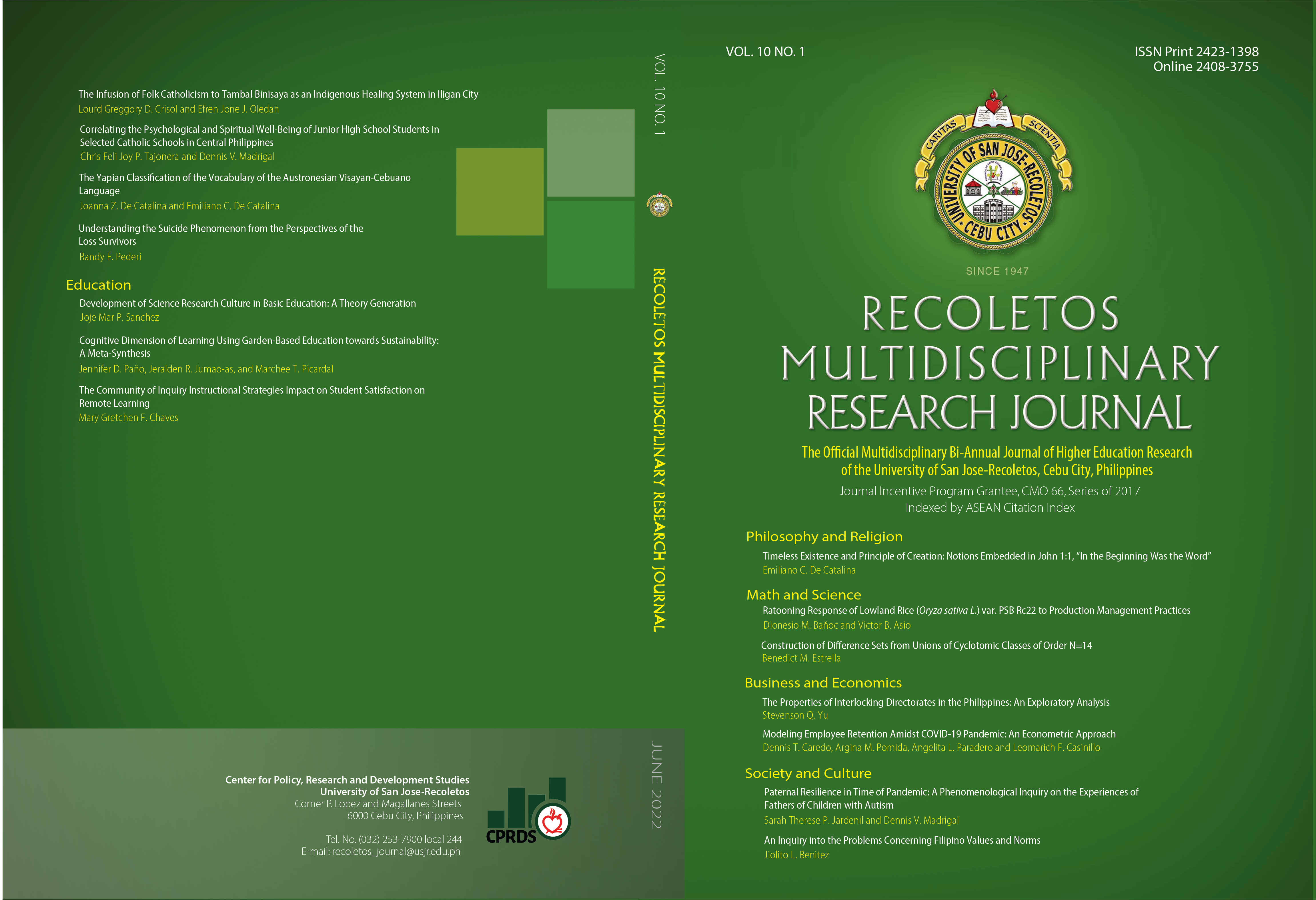Ratooning Response of Lowland Rice (Oryza sativa L.) var. PSB Rc22 to Production Management Practices
DOI:
https://doi.org/10.32871/rmrj2210.01.08Keywords:
approach, gross margin, lowland rice, management, ratooningAbstract
This study aimed to determine the ratooning ability of lowland rice to production management practices. It assessed the profitability of rice ratooning to the abovementioned objectives. The experiment was set out in a split-plot organized in a Randomized Complete Block Design with production management practices as the main plot and cutting heights of ratoon crop as the subplot treatment. Production management practices notably affected all agronomic characteristics, yield, and yield component parameters evaluated except the grain yield. Cutting height remarkably influenced all growth and yield parameters tested except panicle weight. Economic analysis revealed that the improved method achieved a higher gross margin (PHP21,321.60) than the farmer’s practice (PHP15,419.40) because of the former’s high productivity (1.64 t ha-1). A cutting height of 45.0 cm under the improved method obtained the highest gross margin (PHP28,677.00). Moreso, this approach is considered a good measure in adapting to the problematic scenario relative to climate change.
References
Asio, V. B. (1996). Characteristics, weathering, formation, and degradation of soils from volcanic rocks in Leyte, Philippines. Hohenheimer Bodenkundliche Hefte, 33, 209.
Baňoc, D. M. (2020). Ratooning response of lowland rice NSIC Rc352 (Oryza sativa L.) to the method of nitrogen application. Recoletos Multidisciplinary Research Journal, 8(2), 63-74. https://doi.org/10.32871/rmrj2008.02.05
Baňoc, D. M., & Asio, V. B. (2019). Response of lowland rice to fertilization when grown as main and ratoon crop. Annals of Tropical Research, 4(1), 63-80. https://doi.org/10.32945/atr4116.2019
Carating, R. B., Galanta, R. G., & Bacatio, C. D. (2014). The soils of the Philippines. Springer. https://doi.org/10.1007/978-94-017-8682-9
Daliri, M. S., Eftekhari, A., Mobasser, A. H., Tari D. B.M., & Porkalhor, H. (2009). Effect of cutting time and height on yield and yield components of ratoon rice (Tarom Langrodi Variety). Asian Journal of Plant Sciences, 8(1), 89-91. https://doi.org/10.3923/ajps.2009.89.91
Dunand, R. T., & Dilly, R. R. Jr. (2005). First crop cutting height and second crop production in drill-seeded rice. In W. B. Richardson, D. J. Boethel, P. D. Coreil, & S. D. Linscombe (Eds.), 97th Annual Research Report, Rice Research Station (317-318). U.S. Department of Agriculture.
Evatt, N. S., & Beachell, H. M. (1960). Ratoon cropping of short-season rice varieties in Texas. Int. Rice Comm. Newsl., 9(3), 1-4.
Faruq, G., Taha, R. M., & Prodhan, Z. H. (2014). Rice ratoon crop: A sustainable rice production system for tropical hill agriculture. Sustainability, 6(9), 5785-5800. https://doi.org/10.3390/su6095785
Harrel, D. L., Bond, J. A., & Blanche, S. (2009). Evaluation of main-crop stubble height on ratoon rice growth and development. Field Crops Research, 114(3), 396-403. https://doi.org/10.1016/j.fcr.2009.09.011
Ibabao, N. (2018, October 26). Experts from 11 countries gather to shape the future of the rice ratoon cropping system. IRRI News. Retrieved from http://news.irri.org/2018/10/experts-from-11-countries-gather-to.html
Javier, E. F., Marquez, J. M., Grospe, F. S., Mamucod, H. F., & Tabien, R. E. (2002). Three-year effect of organic fertilizer use on paddy rice. Philippine Journal of Crop Science, 27(2), 11-15. https://www.cabi.org/gara/FullTextPDF/2009/20093019271.pdf
Landon, J. R. (1991). Booker tropical soil manual: A handbook for soil survey and agricultural land evaluation in tropics and subtropics. Routledge.
Eastern Visayas latitude and longitude. (2022). DISTANCESTO.COM. https://www.distancesto.com/coordinates/ph/eastern-visayas-latitude-longitude/history/81951.html
Mareza, E., Djafar, Z. R., Suwignyo, R. A., & Wijaya, A. (2016). Rice ratoon yield response to main crops cutting height in tidal swamp using direct seeding system. AGRIVITA: Journal of Agricultural Science, 38(2), 126-132. https://doi.org/10.17503/agrivita.v38i2.502
Nassiri, M., Pirdashti, H., & Nejad, T. N. (2011). Effect of level and time of nitrogen fertilizer application and cutting height on yield and yield component of rice ratooning. Proceedings of the Fourth International Iran and Russia Conference, 602-606. http://iirc.narod.ru/4conference/Fullpaper/20032.pdf
Oad, F. C., Sta. Cruz, P., Memon, M., Oad, N. L. & Hassan, Z. (2002). Rice ratooning management. Journal of Applied Sciences, 2(1), 29-35. https://doi.org/10.3923/jas.2002.29.35
Palchamy A., & Soundrapandian, G. (1988). Status of and potential of rice ratoon cropping in Tamil Nadu. In International Rice Research Institute, Rice ratooning (pp. 111-117). http://books.irri.org/9711041901_content.pdf
Ratilla, M. D., & Cagasan, U. A. (2011). Growth and yield performance of selected lowland rice varieties under alternative wet and dry water management. Annals of Tropical Research, 33(2), 130-142. https://doi.org/10.32945/atr3327.2011
Rice ratooning: A technology to increase production. (2007, April 9). DAWN. https://www.dawn.com/news/241368/rice-ratooning-a-technology-to-increase-production
Santos, A. B., Fageria, N. K., & Prabhu, A. S. (2011). Rice ratooning management practices for higher yields. Communications in Soil Science and Plant Analysis, 34(5-6), 881-918. https://doi.org/10.1081/css-120018981
Saran, A. B., & Prasad, M. (1952). Ratooning in paddy. Curr. Science, 21(8), 223-224.
Singh, B., Mishra, S., Bisht, D., & Joshi, R. (2021). Growing rice with less water: Improving productivity by decreasing water demand. In J. Ali & S. H. Wani (Eds.), Rice improvement: Physiological, molecular breeding and genetic perspectives (pp. 147-170). Springer. https://doi.org/10.1007/978-3-030-66530-2_5
Slaton, N. A., Norman, R. J., Boothe, D. L., Ntamatungiro, S., Clark, S. D., Wilson, C. E., Jr., & Delong, R. E. (2001). Potassium nutrition of rice: Summary of 2000 research studies. In R. J. Norman & J-F Meullenet (Eds.), B. R. Wells rice research studies (395-404). Arkansas Agricultural Research Station. https://agcomm.uark.edu/agnews/publications/485.pdf
University of the Philippines Los Baños. (2018). PSB RC 22 rice. Research Development Extension, Office of the Vice Chancellor for Research & Extension. https://ovcre.uplb.edu.ph/research/our-technologies/article/231-psb-rc-22-rice
Wasli, M. E. & Masni, Z. (2019). Yield performance and nutrient uptake of red rice variety (MRM 16) at different NPK fertilizer rates. International Journal of Agronomy, 2019(2019), 1-6. https://search.emarefa.net/detail/BIM-1155755
Wilson, T. (2001, July). The 54th Annual Beaumont field day rice research impacting the future. Texas Rice: Texas A and M University System Agriculture Research and Extension Center, 1(5), 1-12. https://beaumont.tamu.edu/eLibrary/Newsletter/2001_July_Newsletter.pdf
Ye, T., Li, Y., Zhang, J., Hou, W., Zhou, W., Lu, J., Xing, Y., & Li, X. (2019). Nitrogen, phosphorus, and potassium fertilization affect the flowering time of rice (Oryza sativa L.). Global Ecology and Conservation, 20(2019), e00753. https://doi.org/10.1016/j.gecco.2019.e00753
Downloads
Published
How to Cite
Issue
Section
License
Copyright of the Journal belongs to the University of San Jose-Recoletos


